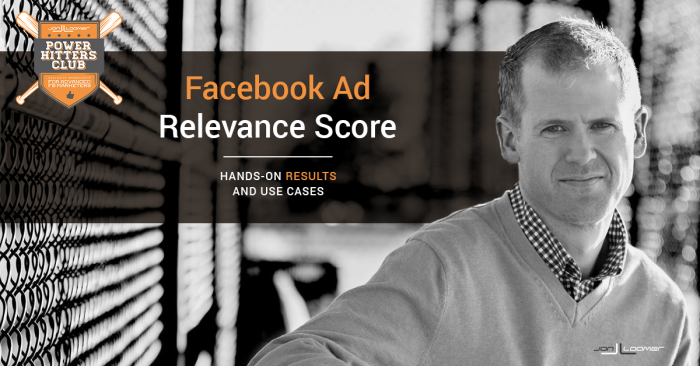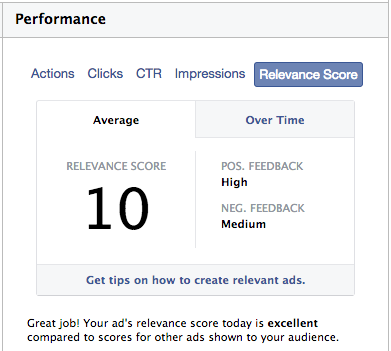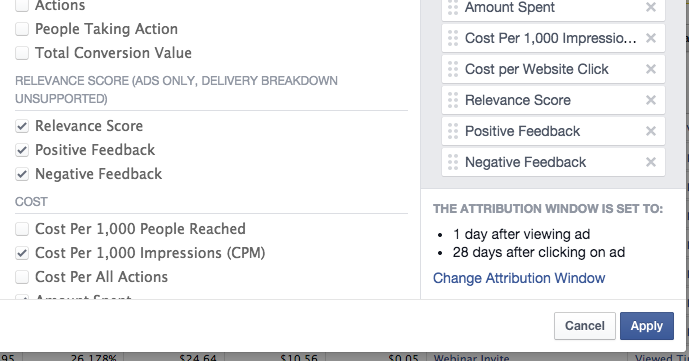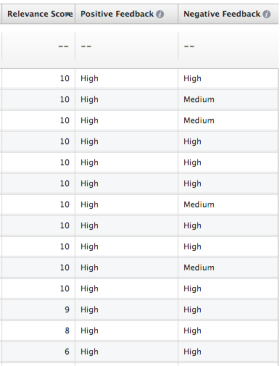
In my recent public blog post, I wrote generally about what Facebook’s new relevance scores are and how they impact advertisers. In this exclusive post for Power Hitters Club members only, I want to dig into how you can uncover this information and what to do with it.
Relevance Scores in Main Ad Overview
When you’re viewing the main ad overview, you will now see a link for “Performance” that includes relevance score…

As you can see, this also includes positive and negative feedback, and whether either is high, medium or low.
Of course, this only allows you to see these scores on an individual ad basis. If you want to compare scores for many ads at once, you’ll need to use the custom ad reports…
Relevance Scores and Custom Ad Reports
First, keep in mind that Facebook started rolling out relevance scores on January 29. As a result, you will only see scores for ads beginning that day.
From your ad reports, click on the “Customize Columns” button…

You’ll want to select a few important metrics based on your objective, but also be sure to click on the following within Settings under “Relevance Score”:
- Relevance Score
- Positive Feedback
- Negative Feedback
You’ll also need to be sure that you’re viewing your reports at the ad level. If you need help with this, make sure to watch the video at the top.
Relevance Score Impacts Pricing
First of all, understand how important a relevance score can be for your advertising. The higher the relevance score, the lower the cost to reach your target audience.
This may sound crazy, but it makes total sense. Facebook wants to show the right content to the right people — including ads — so it will cost more to force Facebook deliver ads with less relevance. If you really want Facebook to show that bad ad, you’ll need to pay for it.
In the past, you just dealt with the costs. But now Facebook is throwing you a warning sign: “Look here, my friend. This ad sucks. We’re not just trying to screw you. It’s time to do something different!”
Of course, that doesn’t mean that relevance scores will always line up perfectly with price. Many factors impact price, including the following:
- Competition for your target audience
- Placement
- Bid (if applicable)
- Relevance score
You may have a higher relevance score for a mobile ad than a right hand column ad, for example, but that doesn’t mean your mobile ad will be cheaper. It just means it will be cheaper to run that exact ad in that exact placement to that exact audience than it would have been had it been less relevant.
Some Problems With Relevance Scores
It’s still early, but I’m seeing some relevance scores that just don’t make sense. For example, I have ads with relevance scores of 10s, but both positive and negative feedback are high.

In that case, I have to assume that positive feedback outweighs negative feedback by a significant margin.
I also have to question how negative feedback is calculated. The examples above are for my Facebook ads experiment. In that case, ads were shown to a small and extremely relevant audience — only those who wanted to see the ads.
This is why positive feedback was so high. But you’d assume that negative feedback would be insanely low — particularly since Facebook has said that negative feedback is only recorded when your targeted audience reacts negatively (these ads often had organic reach of 75% — reaching people who weren’t targeted — because the engagement was so high).
You also shouldn’t lean too heavily on these scores. They are good indicators. They help you understand why Facebook chose a certain ad. They help you quickly decide when to make changes. But the relevance score is not perfect.
End of the day, one metric will always be more important than the relevance score: Cost per desired action.
What I’m Seeing
I don’t mean to brag, but when I run a report of my ads during the past 30 days, I get results for 69 different ads:
- 10: 38
- 9: 19 Ads
- 8: 5 Ads
- 7: 5 Ads
- 6: 1 Ad
- 3: 1 Ad
Now, keep in mind that a lot of this is due to my ads experiment. Regardless, I almost always target either my fans or website visitors — relevancy should always be high.
Ironically, the only ad that received a relevance score of 1 was the multi-product ad that targets PHC users with recent blog posts. However, reach is EXTREMELY low on that — as is cost — so it’s hardly much of an issue.
The one ad that received a 6 was selling PHC membership. I’d consider that pretty good for an ad that sells.
Some other things to consider based on negative feedback that I’m seeing:
- High Negative Feedback: 29
- Medium Negative Feedback: 24
- Low Negative Feedback: 16
Of the 29 ads with high negative feedback, 20 (69%) received relevance scores of 10; of the 24 ads with medium negative feedback, nine (38%) received relevance scores of 10; and of the 16 with low negative feedback, nine (56%) received relevance scores of 10.
Now let’s take a look at positive feedback:
- High Positive Feedback: 64
- Medium Positive Feedback: 4
- Low Positive Feedback: 1
This is where I’m able to spot some trends. In the case of the four ads that received medium positive feedback, all received either 6 (1) or 7 (3) relevance scores. The one ad with low positive feedback had a relevance score of 3.
In other words, negative feedback seems to have very little impact on relevance score. It’s all about positive feedback!
Improve Your Ad’s Relevance Score
Facebook provides some basic tips on how to improve your ad’s relevance score:
1. Be specific with your targeting: You should be doing this all day long. Interests and lookalikes can work, but you’ll almost always be more relevant when targeting your fans (if built properly) or custom audiences.
2. Consider your ad’s image and message: Is the message clear? Do you have grammatical errors? Do you have a clear call-to-action?
3. Refresh your ad: If you’re seeing your relevance score drop, it may be time to try something different!
4. Learn from testing: Over time, you may start spotting trends regarding which audiences react to which copy or imagery the best based on relevance scores.
5. Avoid using offensive content: This is a surefire way to get negative feedback. That said, Facebook’s scale seems to have a low tolerance for negative feedback based on my results, so just getting high negative feedback seems to make little impact.
Your Turn
What types of results are you seeing with relevance scores? Are they consistent with my mine?
Let me know in the comments below!
Category: PHC Blog Uncategorized
 PHC
PHC